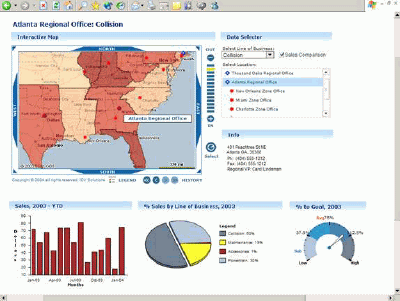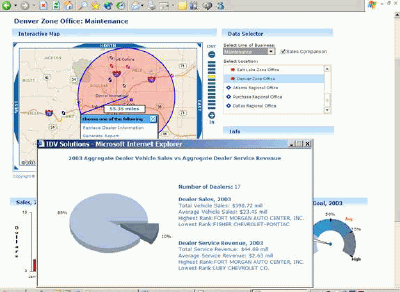This trend is visible in the GIS community where companies like IDV Solutions are using Flash technologies, combined with location enabled enterprise data, as solutions that provide demonstrable return on investment.IDV identified that in order to bring GIS to the next level, any solutions it delivers need to provide seamless integration with existing data and IT infrastructure, and give users rich functionality via the browser, the now default platform for enterprise application development.
Recent product advances provide further evidence of the shift taking place towards enterprise GIS.
- ESRI's ArcWeb Services and Microsoft's MapPoint WebService make map and location services available through IT industry web services standards, thus separating core spatial functionality from desktop GIS software.
- Oracle's 10g database makes spatial data types a standard feature of their industry leading RDBMS, and bases those data types on industry standards, not proprietary GIS vendor formats.
- Many scalable, component based spatial products such as SRC's Allocate demographic engine, can be easily integrated into a .Net or J2EE framework.
So we see a new equation emerging relevant to enterprise GIS: ELSS + RIA = ROI or enterprise location software & services (ELSS) plus rich internet applications provide measurable return on investment.
GIS as part of a bigger
picture
Market intelligence firm
IDC in their May 2004 report entitled "Spatial Information Management:
the Road to Enterprise Systems," divides the spatial information management
(SIM) industry into four segments.GIS is only one of the four segments,
the segment in which geography is the most valuable piece of information.
ELSS, or Enterprise Location Software & Services, on the other hand,
is the segment concerned with geography as a means to an end, the use of
location specific information in a business context.Here, geography augments
business processes and workflows; it is not the focus.

Figure 1.SIM Technology
Segments
Source: ISSI/IDC, 2004
ELSS and Web Mapping
RIAs are one way of fleshing
out ELSS, by providing a way to bring ELSS to the enterprise in a rich,
interactive medium.RIAs are a welcome middle ground between the limits
and disappointments of "thin-client" HTML applications and the hassles
of desktop "fat-client" applications.Thin client applications traded richer
functionality for the ability to distribute via the web, but are often
unsatisfactory for more intensive workflows.RIAs utilize web technologies
such as Flash and scalable vector graphics that allow for more functionality,
and more sophisticated client-side logic and architectures.
Nowhere is the need greater for RIAs than in the area of ELSS.Spatial functionality and map visualization demands enhanced functionality and interactivity, and thin-client applications are not designed to deliver that kind of sophistication.Lots of waiting between map views, limited functionality and poor interfaces do not suffice.
ELSS in action
An example of how IDV Solutions
utilizes RIA technology to provide ELSS solutions will help clarify how
GIS is evolving into a true enterprise technology.
Enterprise Information Portals.A great use of RIA combined with ELSS is within the enterprise information portal.These web based corporate intranet applications are designed to deliver relevant information, from across departments, in an easy-to-use, often visual, interface. Technologically, with ELSS based on IT standards such as web services and XML, and RIAs built on pervasive web technologies such as Flash, the fit within a portal is easily accomplished. Business value is added to an existing application, in this case a portal, through spatial technologies and enhanced user interfaces.
The following screenshots show how such a solution can provide business value.This approach moves beyond web mapping as the be-all, end-all and sets location services and software firmly in an enterprise context.

Click on image for larger
view.
Figure 2. This
screenshot shows sophisticated mapping and spatial functionality within
the context of the enterprise information portal.The purpose of the portal
is to display automobile servicing sales information in a visual and interactive
way across multiple lines of business and multiple geographies; in this
case, regions, zones, and individual dealerships.The "Collision" line
of business for the Atlanta Region is shown in the current view.
For this type of ELSS solution, the existing workflow and toolset is not altered, only enhanced through the addition of location tools such as interactive mapping, thematic shading comparing zone sales levels, spatial selection, and drill down capabilities.

Click on image for larger
view.
Figure 3.In this
second screenshot the user has selected a particular automobile dealer,
John Elway Chevrolet, and is retrieving relevant "Maintenance" revenue
information.The user is able to zoom into that particular dealer through
the map view or through the data selector tool.The legend defines revenue
levels for dealers in that current view, and shows the user, at a glance,
how John Elway Chevrolet compares to other dealers.
Key to adding enterprise value through ELSS is the integration with enterprise data sets and applications. In this case, the business data is coming from back-end systems and the portal itself is an existing application.Utilization of component based client-side functionality and web standards on the server-side enable easier integration.
Figure 4.Through RIA technology, richer functionality is added to browser based applications as seen in this next screenshot.Here the user utilizes a radius selection tool to generate a quick aggregate report on dealers surrounding a particular location point.The user could have just as easily, using this same tool, generated an Excel spreadsheet of that same set of dealer locations.
Advanced functionality through RIA significantly increases usability and productivity.In only one page view, the user is able to retrieve large amounts of data in many different formats: textual reports, information graphics, and spreadsheets.
Conclusion
While the concept of enterprise
GIS is not new, recent developments and new technologies like RIA are providing
a foundation for the rapid adoption of powerful ELSS solutions.Companies
implementing these technologies now will realize significant competitive
advantages as they leverage the power of spatial information management.
